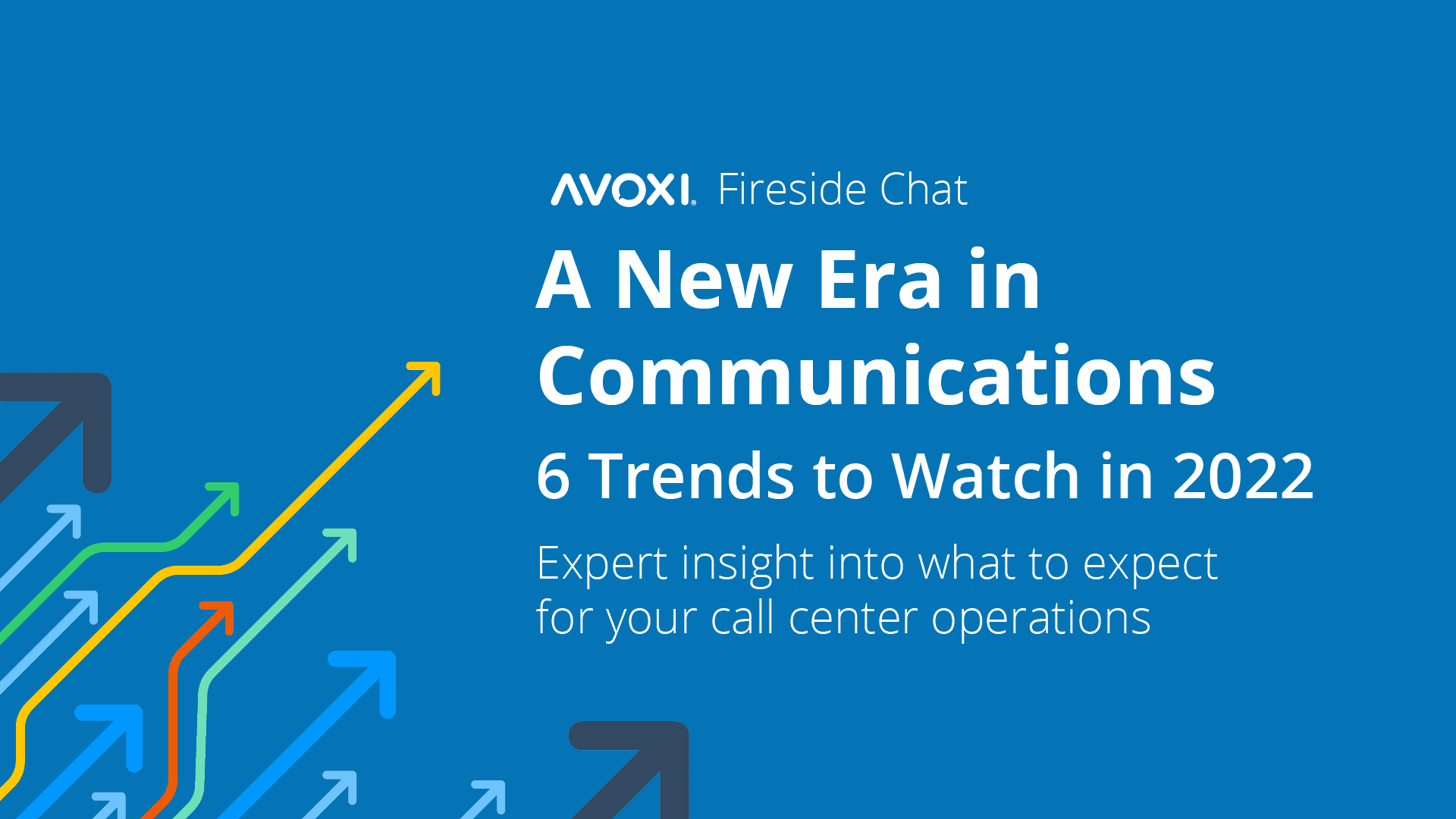Recent Trends in Business Communication
New & Emerging Business Communication Trends for 2022
Expert insight into what to expect for your call center operations
VoIP Industry Experts
 |
Barbara Dondiego
COO
|
 |
Kyle Johnson
CRO
|
 |
Randy LaymanCTOAVOXI |
 |
Megan EvittsDigital Events ManagerAVOXI |
Trend 1: Business Operations Live in the Cloud
Adoption of cloud based applications will continue increasing to allow for remote work, disaster preparedness and effective business communications
| MEGAN: | The first trend that we're going to cover today is the growing need for cloud-based solutions. So cloud-based technology has evolved from simple back-end data storage tools to really modern solutions that can practically run an entire business. So Kyle, kick us off with what we can expect in 2022 and how businesses can better prepare for unplanned setbacks using this cloud-based technology. |
| KYLE: | Yeah great question Megan. First off, cloud is here to stay. You know, I read one of the analyst reports recently that said the cloud services market is expected to surpass 1.3 trillion by 2025, so just you know tremendous growth. I'll date myself a little bit but I remember back to the earlier days of cloud communication solutions when no one really understood what it was, no one trusted it and trying to convince decision makers that this was the thing of the future was incredibly tricky. I do think those days are behind us and the majority of businesses have moved to cloud adoption for large portions of their business tools, communication certainly being a huge part of that. It's also moved from just back end and data storage solutions to frontline customer facing solutions so you can kind of see the trust that these businesses are now putting in different cloud solutions and cloud applications.In terms of what we can expect in 2022, more and more business tools and processes are going to continue to move to the cloud as I believe we all saw over the past couple of years that businesses that plan for that disaster event fared well, others really struggle to figure out how to have their employees remote still communicate with and serve their customers and to be able to use those business tools that may have otherwise been local to the office locations. What one of our big drivers has been is to ensure that our customers' ability to serve their customers was not negatively impacted. Our cloud communication solutions were purpose built in and for the cloud so I love that we were able to help thousands of customers go remote and not miss a beat and we did that in minutes not days or weeks. I also don't want to steal too much of Barbara and Randy's thunder, but we also developed a lot of integrations to other business tools that again it helps simplify our customers day-to-day operations. |
Cloud Communication Trends Summary
Segue into 2-3 bullets summarizing the experts' discussion of UCaaS trends / the future of the UCaaS market.
International Remote Workforce Management
Easily onboard and support agents around the globe with access to more robust business communication services in the cloud
Benefit from Consolidating Multiple Technologies
Improve the customer and agent experience, save time and reduce costs by migrating from an on-premise PBX system to the cloud
Modern Cloud Based Solutions for Business Operations
AVOXI’s cloud communications solutions were purpose-built in and for the cloud to simplify day-to-day operations for our customers
Trend 2: 5G Networks Fuel Remote Work Trends in 2022
Reliable access to mobile networks is getting easier as the 5G coverage map continues to expand
| MEGAN: | All right so the next one we're going to talk about is 5g and the impact that the gradual mainstream rollout that we're seeing of this service is going to have on the future of global connectivity. So Randy, I've heard a lot of hype around this topic; it seems like 5g could just be the solution to getting internet access to these rural communities all around the world but I do know that there's major concerns with things like market availability and variations in performance, so what are your predictions for how 5g is going to affect global communications this next year? |
| RANDY: | Talking about gradual mainstream, that is so perfect for 5g right it is ebbs and flows. You know here in the United States t-mobile, verizon and AT&T just had to dial back the power on their transmitters because the FAA has concerns about it. We're still not quite to the point that it's a reliable, dependable technology you can base your everyday work on. I think that will change for people in urban areas in 2022. I think that larger roll out to all of the world, all of the rural areas within the developed countries, I think that's going to take a little bit longer. One of the things that you know in late 2022 as we look into 2023, I think that then starts to enable not just remote work but nomadic work. Now I don't have to have this fixed internet connection, I can take my 5g and I can go wherever I want, you know I can hop in the RV and drive across the country and still be working day in and day out and it not really impact my productivity, so I think you know in 2022 we'll see a lot more roll outs, a lot more adoption. I think we'll see some of the kinks worked out around things like battery life and power consumption, and towards the end of the year we'll really see this take off and really be penetrating into a consumer market and kind of enabling some new work styles even beyond the current remote work that we we're seeing now |
| MEGAN: | Great, Barbara, Kyle, do you have anything to add to that? |
| BARBARA: | The only thing I'll add is that 5g is kind of like the hot buzzword but there's a lot of optimization that's going on even with the existing wireless networks in many countries so that the performance on them. You know we have employees that work at times off of wireless networks we all work at times off of wireless networks you know while we're driving down the road or doing you know we have done RV trips and kept on working even though 5g isn't prevalent throughout any country yet really and I just think there's a lot of optimization and technology that's happening that allows even the current wireless networks to work much better you know to keep everybody going and to keep everyone you know working wherever they need to and being connected and really giving employees that flexibility. |
| MEGAN: | Okay Kyle do you have anything to add? |
| Kyle: | Yeah just to really come along with what Barbara said I mean that flexibility is key, and to be clear, we have someone else driving while we're working down the road because we don't do both of those at the same time, but again, it's become so important to that workforce today and so for companies to recognize that and then build their tech stack and solutions around it, I think it'll be incredibly impactful. |
5G Trends Summary
Let's summarize our experts' discussion on 5G trends to watch in 2022.
5G Offers Internet Access to Rural and Underdeveloped Countries
While it will be most impactful for urban regions, businesses will enjoy greater reach and higher quality of service globally
The Nomadic Work Trend Takes Off
With 5G access, employees can conduct business from practically anywhere without affecting productivity
Reduced Latency Brings Faster and More Secure Communication
Paired with a reliable communications partner, businesses will benefit from lower latency with 5G, ensuring efficient collaboration with no down time
Trend 3: Cloud Communications Innovate in VoIP Security & Regulatory Compliance
With VoIP security threats at an all time high, communication and network security protection are top priority for successful business operations in 2022
| MEGAN: | All right, so the next trend that we're going to talk about is the growth of UCaaS and the rise of mobile unified communications. So while the concept has been around for a while, the as of service and mobile aspects are relatively new. So Barbara, how do you see this trend evolving in 2022 and what can businesses do to take advantage of the developments in this technology? |
| BARBARA: | Yeah so I think this has certainly become very interesting and it kind of links to the whole concept of having more flexibility, having more things in the cloud and having more ability for employees to really work wherever they are. For me the standout in 2022 and also in 2021 is really the MS Teams platform. We do a few different integrations with MS Teams, but you know if you think, MS Teams has grown to take on like 10% of the whole UCaaS market over a really small amount of time. There are certain things though that if you want to go global and be international, like a lot of the AVOXI customers, MS Teams needs some partnership and and that's where AVOXI has our MS Team's direct routing solution and we're able to integrate with that platform in a couple of different ways. But just the fact that MS Teams has been able to take such a large market share, they have a desktop version, they have a mobile version- I think it just sort of sets a path for where we think the UCaaS market is going and how easy and simple and integrated that type of platform should be. |
| MEGAN: | Kyle, Randy do you have anything to add to that? |
| RANDY: | I think the one thing to add to extend on what Barbara's saying a little bit, is the UCaaS has become so ubiquitous right? There used to be a time that you could start a company and you didn't really have to have that communication platform, or if you did you had your brother-in-law you know set up some box in the corner of your office and you got a little bit of a phone system with that. But in today's world, we're so highly collaborative, you know we've been talking about remote work, you need that platform that kind of brings all that collaboration together. UCaaS is so important in that kind of cohesive team environment, whether it's Microsoft Teams or if it is kind of the slack zoom ecosystem, whichever one of the families that you're in, UCaaS is just so critical to keeping that remote workforce productive and able to keep turning forward. |
| BARBARA: | I think Randy, that's a great point. It's not just about voice right, it's not just about the communication part of that or the traditional phone system or the traditional platform, it's more about all these different collaboration tools so that you can chat and you can take notes and you can have shared documents and you can have shared websites with the documents and all those pieces that integrate into how you're really working, not just within your own company but even with your clients as well, and your vendors inside and outside. |
Regulatory Comliance & VoIP Security Trends Summary
Let's summarize our experts' discussion on regulatory compliance and VoIP security trends to watch in 2022.
Increased cyber security threats will continue in 2022
Relying on trusted cloud communications partners like AVOXI is critical for ensuring network protection and regulatory compliance.
Unified Communications at Global Scale
AVOXI's network is optimized for local voice termination in South Africa. That means crystal-clear call quality and outbound caller ID that works every time.
VoIP Security & Education for Employees
Business leaders will need to invest in continued education for employees on ways of identifying potential threats.
Trend 4: Global, Mobile Unified Communications
In the new normal, the future of unified communications lies in mobile-ready solutions at a global scale.
| MEGAN: | All right, so the next trend that we're going to talk about is the growth of UCaaS and the rise of mobile unified communications. So while the concept has been around for a while, the as of service and mobile aspects are relatively new. So Barbara, how do you see this trend evolving in 2022 and what can businesses do to take advantage of the developments in this technology? |
| BARBARA: | Yeah so I think this has certainly become very interesting and it kind of links to the whole concept of having more flexibility, having more things in the cloud and having more ability for employees to really work wherever they are. For me the standout in 2022 and also in 2021 is really the MS Teams platform. We do a few different integrations with MS Teams, but you know if you think, MS Teams has grown to take on like 10% of the whole UCaaS market over a really small amount of time. There are certain things though that if you want to go global and be international, like a lot of the AVOXI customers, MS Teams needs some partnership and and that's where AVOXI has our MS Team's direct routing solution and we're able to integrate with that platform in a couple of different ways. But just the fact that MS Teams has been able to take such a large market share, they have a desktop version, they have a mobile version- I think it just sort of sets a path for where we think the UCaaS market is going and how easy and simple and integrated that type of platform should be. |
| MEGAN: | Kyle, Randy do you have anything to add to that? |
| RANDY: | I think the one thing to add to extend on what Barbara's saying a little bit, is the UCaaS has become so ubiquitous right? There used to be a time that you could start a company and you didn't really have to have that communication platform, or if you did you had your brother-in-law you know set up some box in the corner of your office and you got a little bit of a phone system with that. But in today's world, we're so highly collaborative, you know we've been talking about remote work, you need that platform that kind of brings all that collaboration together. UCaaS is so important in that kind of cohesive team environment, whether it's Microsoft Teams or if it is kind of the slack zoom ecosystem, whichever one of the families that you're in, UCaaS is just so critical to keeping that remote workforce productive and able to keep turning forward. |
| BARBARA: | I think Randy, that's a great point. It's not just about voice right, it's not just about the communication part of that or the traditional phone system or the traditional platform, it's more about all these different collaboration tools so that you can chat and you can take notes and you can have shared documents and you can have shared websites with the documents and all those pieces that integrate into how you're really working, not just within your own company but even with your clients as well, and your vendors inside and outside. |
UCaaS Trends Summary
Let's summarize our experts' discussion on UCaaS trends to watch in 2022.
Mobile Applications for UCaaS
High-quality outbound voice service unlimited SIP channels (concurrent calling) in South Africa.
Unified Communications at Global Scale
AVOXI's network is optimized for local voice termination in South Africa. That means crystal-clear call quality and outbound caller ID that works every time.
International Connectivity Drives UCaaS Market Growth
Whether you're making local calls to South Africa or connecting internationally, AVOXI provides a seamless voice experience anywhere you do business.
Trend 5: API Drives Competitive Customer Service Strategies
As competition increases, businesses are implementing API to automate repetive tasks and drive higher customer satisfaction scores.
| MEGAN: | So this next trend that we're going to talk about is using API’s to achieve customer satisfaction and maintain a competitive advantage. So Barbara, we hear a lot about companies using API’s to improve CSAT scores, but what does that mean, how do they do it and how do you see this trend continuing to evolve into next year? |
| BARBARA: | Yeah so I mean talking about APIs is kind of a technical thing to talk about but it's really just a different way to integrate information into your business tools so that you can deliver a faster experience to your customers with higher levels of accuracy. That's really the point of it, right? You know we used to call it a long time ago, now I'm dating myself, we used to call it e-bonding if you remember, that's a really old term, but essentially yeah that's what APIs do but in a really more simple, elegant and easy way. So anytime you think about information in one system and you can then get that information into whatever other system you need to get it to and you have it you have it there no one has to type it in for you, you don't have to worry about swivel chairing to the system. That's really what it is, so that can improve your service in a lot of ways, right? So you're going to have better data accuracy, you're going to have better visibility into multiple things in one place, you're going to maybe be able to serve up things to your customers more quickly and easily. So, to me all those things are great and you know we're seeing in even operations teams and you know maybe professional services teams are starting to offer those types of integration services with API tools for clients and for their own teams as well, because everything really needs to be put together in one package and it all needs to flow.
So I just see more of the same. I think that's going to continue. I think the days of saying that all the people that can deal with APIs and that can integrate services or in like an IT team or in a development team, I think that's going away just like a long time ago anybody that could do a query or a new sql or in a specialized group, I think all that's going to be sort of normalized out into every different team so that you know the sales organizations will have someone that can do APIs and integrations and operations teams will have those people as well and they'll start to integrate in all their tools and create those unified processes. |
| KYLE: | I really think Barbara hit the nail on the head there with as you think about how you improve your CSAT or your customer experience, it's really I think two main things that speed and accuracy right so how quickly do you address their concern and do you address it as accurately as possible and so again as Barbara described those APIs those tools just really helped that service professional be able to do that and again it translates into really happy customers and really happy customers continue doing business with you. |
| RANDY: | I think the only thing kind of going back to what Barbara said, you know the people moving outside of that specialized IT group also changes what those tools have to look like, right? Now you know we can't require a CS degree anymore and three years professional experience but we need to be looking at those tools that have you know what people refer to as the no code low code environment or interface where it's much more drag and drop much more self-explanatory and intuitive for you know the average office worker to be able to interact with it so I think that's going to be one of the big trends we see 2022 and beyond is how do we continue to make these integrations these moving data from point A to point B how do we make that simple fast and accurate. |
API Trends Summary
Let's summarize our experts' discussion on API trends to watch in 2022.
Improve the Customer Experience
Integrate information into your tech stack to deliver a faster experience to your customers with higher levels of accuracy, improve processes and workflows and drive more efficiency
Increased Visibility with API Integrations
Forward thinking businesses are integrating a multitude of advanced tools like Chatbots for a truly unified communication experience,making real-time support accessible to all customers from anywhere in the world.
The Shift to Low-Code/ No-Code
APIs have evolved - with a rise in low-code/ no-code API solutions, the average employee can now implement integrations quickly, allowing businesses to get new products to market faster.
Trend 6: Contact Center AI to Transforms Unified Communications in 2022
In the new normal, the future of unified communications lies in mobile-ready solutions at a global scale.
Artificial intelligence in the contact center is easier to implement than ever and drives significantly more positive customer interactions for call centers that implementing AI.
| MEGAN: | So the last trend that we're gonna touch on today is artificial intelligence. So I think that most businesses probably understand the importance of AI but, I think that most probably still struggle with how to deploy it and how to adopt the technology in actual truly meaningful ways. So Kyle, can you provide some insight into the future of AI in the call center environment and then how businesses can potentially navigate implementation challenges in the future? |
| KYLE: | Yeah I'd love to take that one and I will say with Barbara being a product expert and Randy really being an engineering expert, I can't wait to hear their thoughts on it as well, but I think that AI is one of the most technologically advanced business trends that we should anticipate to have an impact in 2022. So I think there's a lot of advantages to incorporating AI solutions into your business communications plan, but I also still think there's a lot of challenges that businesses are going to face as well. You know one of the biggest advantages that I can think of with an AI complemented tool, is being able to help automate many of the routine tasks that humans were having to perform. So in the example of an inbound call center you can group together the most frequent issues that a customer service rep may have to handle and you can employ an AI solution against that, whether it lives in your IVR or chat or wherever, you can address that customer's needs while freeing up the reps time to allow them to focus on the more complex issues that a customer may need help with so again kind of that speed and accuracy. So in other words, it creates efficiencies that should translate into better productivity and a better customer experience, which I think again is one of the most important pieces.
On the challenges side, I think there are very explicit use cases, sometimes thousands of hours of data go into a model that can be unique to each business, and so I will say businesses do need to be prepared to invest time into properly implementing and assigning resources. That being said, I do think part of our job is to figure out a way to make those AI powered tools easier to implement, easier to consume for our business partners and customers. |
| RANDY: | I think to kind of continue on with what Kyle's saying- one of the big areas for AI, and I kind of think AI is at this cusp where we're now about to get to the point that the average company can start taking advantage of it. I think another really promising area for this in the contact center is actually assisting the supervisors, right? As you have the supervisors they're trying to manage 10, 20, 30 growing numbers of agents- how do we help them know which agents that they need to be interacting with, which ones are they coaching, which ones are they giving the pat on the back, the great job, which ones are they considering for promotion? All of those types of things, how do we get that feedback and really give the agents? Hey you could have done this a little bit better, you're a little bit off script, great job saving this phone call - all of those types of things, I think is something that we'll start to see really coming to the contact center tools in 2022. And really being able to bring some of that functionality that maybe the largest of the large contact centers have now, bringing that down to more of the average sized contact center capabilities this year. |
| KYLE: | Yeah and I really love that example you gave, Randy, about the supervisor because if you think about again, dating myself the old days of a supervisor having to spend hundreds and hundreds of hours, you know trying to listen through the calls and figure out what's going on, these AI tools give, what I call actionable intelligence and so it really highlights for them and pinpoints - here's the exact area you should focus on and here's the person or people you should focus that effort on and so I think that was a fantastic example. |
| RANDY: | The old days, the supervisor would spend eight hours a day listening to come up with one hour of coachable content. Improving that ratio just lets the supervisor be so much more effective in what they are coaching about. |
| BARBARA: | I think the point about the next best action - with all this data you kind of go into, you're integrating with APIs, you have everything in the cloud, all of your systems are together, you have all this different information that you're collecting and then being able to pull that into something that isn't just information but actually helps you move forward with a client or with your product is really where we all would like to see the AI tools go. And not where you have to have you know a staff of 10 phds and and tons and tons and tons of data that might be hard for normal companies to put together, but something that simple- like I want to know when someone's going to cancel an order, or I want to know all the calls where a customer seems you know more upset than normal, or I want to know all the calls where a customer seems more happy than normal. And just some of those buckets of categories -and all the calls that are customer seems more happy than normal and they're over four minutes long or something like that will allow them to say these are the ones that you should really be coaching on or you should really be looking at. It's exciting, Ii think it's almost there, I agree with Randy on that I think it's coming to where you would have a simple toolkit and that's what we hope to you know work on too out of AVOXI is provide simple and elegant tools for our customers so they can take this technology and there's a lot of things going on in the background but all you see on the front is something that's easy to use. |
| 27:24:20 | Final Thoughts |
| MEGAN: | That was the end of the six trends that we're going to cover. Do you guys have any other final thoughts that you wanted to share with our audience before I kind of wrap it up here |
| BARBARA: | I'll just say I think that we're all excited about 2022. I mean 2021 and 2020 have had ups and downs for sure. I mean in the tech space we've had a lot of growth, but we've had a lot of challenges too. Everybody has in these past couple of years and we're really excited for 2022 to be what we’d consider maybe a normal trend in the business and see what that looks like. But, of course it will never be the same as it was before because the world has changed so much and how we work has changed and technology has moved forward and adoptions move forward so we're really excited to see what that year holds for us. |
| KYLE: | Yeah I couldn't agree more on that. One of the things that really excites us is being able to talk to or listen to our customers and figure out you know what things can be super impactful for their business and then we go off and build it for them and so I'm super excited as well about kind of what 2022 holds and how we can continue to deliver really best in class experience for our customers. |
| RANDY: | I think just echoing what Kyle and Barbara said, you know 2022 from where we're looking right now it's got to get better, right, and it's got to be a great improvement in the world. Hopefully we're going to be able to put some of the challenges of the global challenges of 2020 and 2021 behind us and we're all excited about that and we're excited about you know the cool things that we're working on building, the things that we're getting our customers hands in the next couple of months and throughout the entire year. |
| MEGAN: | All right well thank you so much Barbara, Kyle and Randy for sharing your thoughts on what 2022 has in store for call center operations. We really appreciate everyone's time today and hope that you're finding the insight that we shared valuable as you're finalizing your communication strategies for next year. We are more than happy to answer any questions that you may have following this webinar. Simply email us at [email protected]. Thanks for joining! |
Contact Center AI Trends in 2022
Let's summarize our experts' discussion on contact center AI trends to watch in 2022.
AI to Transform Unified Communications
Automate many routine tasks and create efficiencies that should translate into better productivity and a better CX.
AI is on the Cusp of Easy Implementation for Any Business
It can take thousands of hours of data to create a model that’s unique to a business, but advancements in this technology will allow vendors to broaden AI functionality for general use.
AI Applications to Watch
Answer bots, natural language, speech to text - also provides actionable intelligence for supervisors to better monitor and coach agents.

